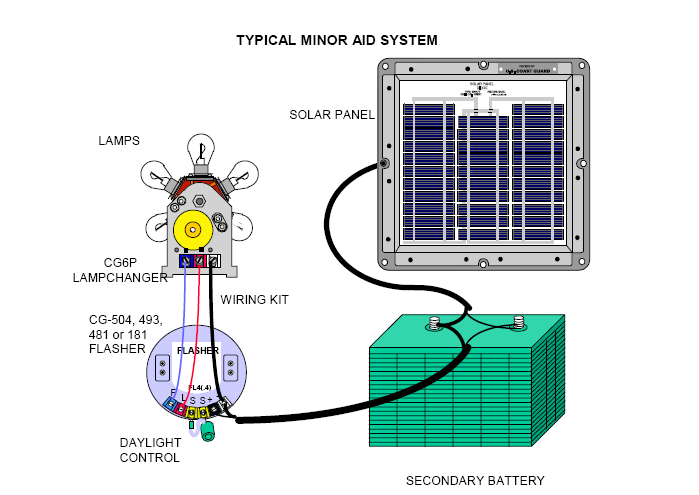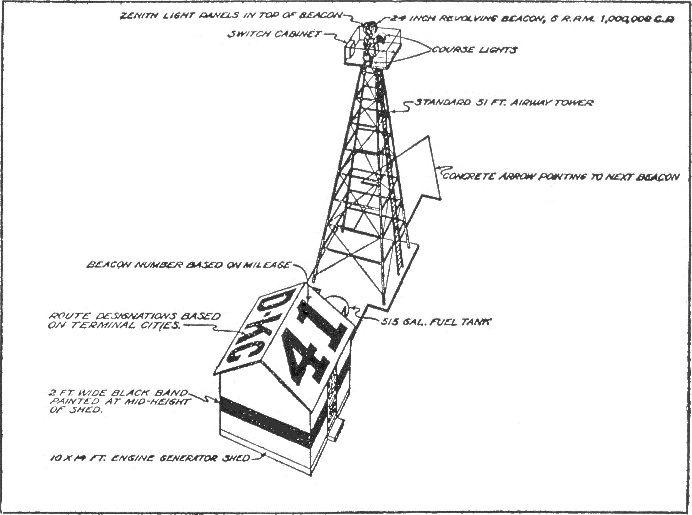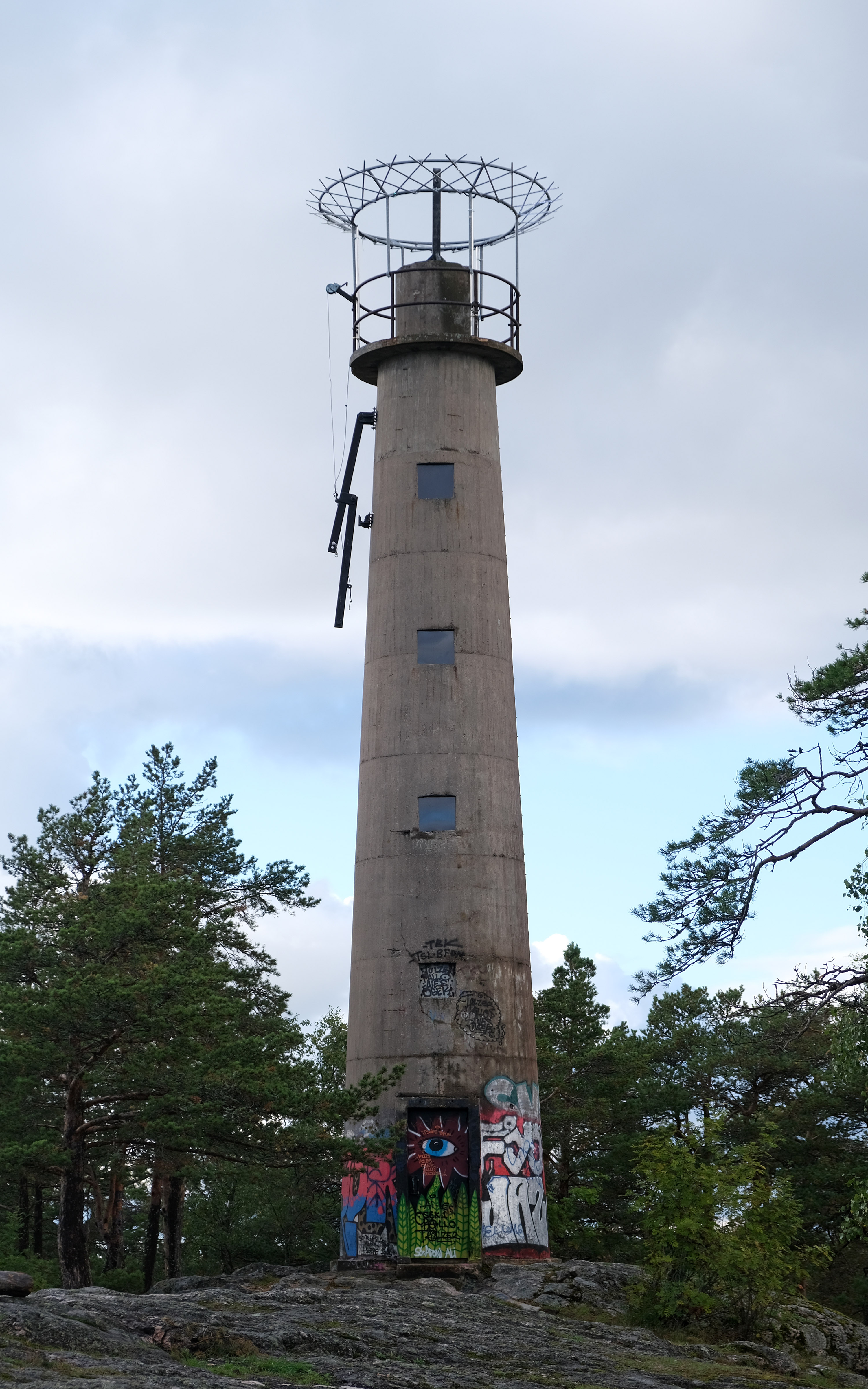|
Aerobeacon
An aerobeacon is a light assembly used to create a fixed or flashing signal visible over long distances. It consists of a high intensity electric lamp mounted with a focusing device in a cylindrical housing, which usually is rotated on a vertical axis by an electric motor. The sweep of the narrow beam thus produced gives the flashing effect. Aerobeacons were originally developed for aviation use, mostly as aerodrome beacons, but they also saw extensive use in lighthouses. They were far less expensive to manufacture and maintain than classic glass Fresnel lenses, and much more durable; they could be mounted and exposed to the weather. Historic models include the DCB-24, which used a single parabolic reflector; the DCB-224, a double-beamed version of the DCB-24; and the DCB-36, which used a system of plastic Fresnel type lenses. Manufacturers included Carlisle & Finch in Cincinnati and the Crouse-Hinds Company in Syracuse, New York. Aerobeacons have replaced fragile glass Fresnel le ... [...More Info...] [...Related Items...] OR: [Wikipedia] [Google] [Baidu] |
Lighthouse Fixtures
A lighthouse is a tower, building, or other type of physical structure designed to emit light from a system of lamps and lenses and to serve as a beacon for navigational aid, for maritime pilots at sea or on inland waterways. Lighthouses mark dangerous coastlines, hazardous shoals, reefs, rocks, and safe entries to harbors; they also assist in aerial navigation. Once widely used, the number of operational lighthouses has declined due to the expense of maintenance and has become uneconomical since the advent of much cheaper, more sophisticated and effective electronic navigational systems. History Ancient lighthouses Before the development of clearly defined ports, mariners were guided by fires built on hilltops. Since elevating the fire would improve the visibility, placing the fire on a platform became a practice that led to the development of the lighthouse. In antiquity, the lighthouse functioned more as an entrance marker to ports than as a warning signal for reefs and ... [...More Info...] [...Related Items...] OR: [Wikipedia] [Google] [Baidu] |
CG-2P
An automatic lamp changer (or lampchanger) is a device used to ensure that a navigational light such as a marine lighthouse or aero beacon stays lit even if a bulb burns out. Numerous types exist. The common design elements are an array of two or more lamps (or bulbs), installed on a mounting which can rotate to various positions. Each position brings a different lamp into the focal point of an optical assembly. Since signal and navigational lights use sophisticated optics to focus the beam, lampchangers are designed to position the new bulb at the focal point with high precision. The device automatically detects when the currently active lamp has ceased to function and moves the next lamp into place. History The automatic lampchanger was invented by Charles Wallace and patented in 1928. This original model held two headlight lamps from a Model T automobile. The United States Lighthouse Service had these in common use by the 1930s, as they moved to convert all navigational lights t ... [...More Info...] [...Related Items...] OR: [Wikipedia] [Google] [Baidu] |
Lighthouse
A lighthouse is a tower, building, or other type of physical structure designed to emit light from a system of lamps and lenses and to serve as a beacon for navigational aid, for maritime pilots at sea or on inland waterways. Lighthouses mark dangerous coastlines, hazardous shoals, reefs, rocks, and safe entries to harbors; they also assist in aerial navigation. Once widely used, the number of operational lighthouses has declined due to the expense of maintenance and has become uneconomical since the advent of much cheaper, more sophisticated and effective electronic navigational systems. History Ancient lighthouses Before the development of clearly defined ports, mariners were guided by fires built on hilltops. Since elevating the fire would improve the visibility, placing the fire on a platform became a practice that led to the development of the lighthouse. In antiquity, the lighthouse functioned more as an entrance marker to ports than as a warning signal for reefs a ... [...More Info...] [...Related Items...] OR: [Wikipedia] [Google] [Baidu] |
Fresnel Lens
A Fresnel lens ( ; ; or ) is a type of composite compact lens developed by the French physicist Augustin-Jean Fresnel (1788–1827) for use in lighthouses. It has been called "the invention that saved a million ships." The design allows the construction of lenses of large aperture and short focal length without the mass and volume of material that would be required by a lens of conventional design. A Fresnel lens can be made much thinner than a comparable conventional lens, in some cases taking the form of a flat sheet. The simpler dioptric (purely refractive) form of the lens was first proposed by Count Buffon and independently reinvented by Fresnel. The ''catadioptric'' form of the lens, entirely invented by Fresnel, has outer elements that use total internal reflection as well as refraction; it can capture more oblique light from a light source and add it to the beam of a lighthouse, making the light visible from greater distances. Description The Fresnel lens redu ... [...More Info...] [...Related Items...] OR: [Wikipedia] [Google] [Baidu] |
Aerodrome Beacon
An aerodrome beacon or rotating beacon or aeronautical beacon is a beacon installed at an airport or aerodrome to indicate its location to aircraft pilots at night. An aerodrome beacon is mounted on top of a towering structure, often a control tower, above other buildings of the airport. It produces flashes similar to that of a lighthouse. Airport and heliport beacons are designed in such a way to make them most effective from one to ten degrees above the horizon; however, they can be seen well above and below this peak spread. The beacon may be an omnidirectional flashing xenon strobe, or it may be an aerobeacon rotating at a constant speed which produces the visual effect of flashes at regular intervals. Flashes may be of one, two, or three alternating colors ( described below). In the United States In the United States, the Federal Aviation Administration (FAA) has established the following rules for airport beacons: Flashing rates # 24 to 30 per minute for beacons marki ... [...More Info...] [...Related Items...] OR: [Wikipedia] [Google] [Baidu] |
Automatic Bulb Changer
An automatic lamp changer (or lampchanger) is a device used to ensure that a navigational light such as a marine lighthouse or aero beacon stays lit even if a bulb burns out. Numerous types exist. The common design elements are an array of two or more lamps (or bulbs), installed on a mounting which can rotate to various positions. Each position brings a different lamp into the focal point of an optical assembly. Since signal and navigational lights use sophisticated optics to focus the beam, lampchangers are designed to position the new bulb at the focal point with high precision. The device automatically detects when the currently active lamp has ceased to function and moves the next lamp into place. History The automatic lampchanger was invented by Charles Wallace and patented in 1928. This original model held two headlight lamps from a Model T automobile. The United States Lighthouse Service had these in common use by the 1930s, as they moved to convert all navigational lights t ... [...More Info...] [...Related Items...] OR: [Wikipedia] [Google] [Baidu] |
Aerodrome Beacon
An aerodrome beacon or rotating beacon or aeronautical beacon is a beacon installed at an airport or aerodrome to indicate its location to aircraft pilots at night. An aerodrome beacon is mounted on top of a towering structure, often a control tower, above other buildings of the airport. It produces flashes similar to that of a lighthouse. Airport and heliport beacons are designed in such a way to make them most effective from one to ten degrees above the horizon; however, they can be seen well above and below this peak spread. The beacon may be an omnidirectional flashing xenon strobe, or it may be an aerobeacon rotating at a constant speed which produces the visual effect of flashes at regular intervals. Flashes may be of one, two, or three alternating colors ( described below). In the United States In the United States, the Federal Aviation Administration (FAA) has established the following rules for airport beacons: Flashing rates # 24 to 30 per minute for beacons marki ... [...More Info...] [...Related Items...] OR: [Wikipedia] [Google] [Baidu] |
Lighting
Lighting or illumination is the deliberate use of light to achieve practical or aesthetic effects. Lighting includes the use of both artificial light sources like lamps and light fixtures, as well as natural illumination by capturing daylight. Daylighting (using windows, skylights, or light shelves) is sometimes used as the main source of light during daytime in buildings. This can save energy in place of using artificial lighting, which represents a major component of energy consumption in buildings. Proper lighting can enhance task performance, improve the appearance of an area, or have positive psychological effects on occupants. Indoor lighting is usually accomplished using light fixtures, and is a key part of interior design. Lighting can also be an intrinsic component of landscape projects. History With the discovery of fire, the earliest form of artificial lighting used to illuminate an area were campfires or torches. As early as 400,000 years ago, fire was kindl ... [...More Info...] [...Related Items...] OR: [Wikipedia] [Google] [Baidu] |
Airway Beacon
An airway beacon (US) or aerial lighthouse (UK and Europe) was a rotating light assembly mounted atop a tower. These were once used extensively in the United States for visual navigation by airplane pilots along a specified airway corridor. In Europe, they were used to guide aircraft with lighted beacons at night. UK and Europe United Kingdom A network of aerial lighthouses was established in the United Kingdom and Europe during the 1920s and 1930s. Use of the lighthouses has declined with the advent of radio navigation aids such as NDB (non-directional beacon), VOR (VHF omnidirectional ranging) and DME (distance measuring equipment). The last operational aerial lighthouse in the United Kingdom is on top of the cupola over the RAF College main hall at RAF Cranwell. Netherlands In the Netherlands, gas holders were painted with an arrow pointing north and two letters identifying their location. United States Approximately 1,500 airway beacons were constructed to guide ... [...More Info...] [...Related Items...] OR: [Wikipedia] [Google] [Baidu] |
Aerial Lighthouse
An airway beacon (US) or aerial lighthouse (UK and Europe) was a rotating light assembly mounted atop a tower. These were once used extensively in the United States for visual navigation by airplane pilots along a specified airway corridor. In Europe, they were used to guide aircraft with lighted beacons at night. UK and Europe United Kingdom A network of aerial lighthouses was established in the United Kingdom and Europe during the 1920s and 1930s. Use of the lighthouses has declined with the advent of radio navigation aids such as NDB (non-directional beacon), VOR (VHF omnidirectional ranging) and DME (distance measuring equipment). The last operational aerial lighthouse in the United Kingdom is on top of the cupola over the RAF College main hall at RAF Cranwell. Netherlands In the Netherlands, gas holders were painted with an arrow pointing north and two letters identifying their location. United States Approximately 1,500 airway beacons were constructed to guide p ... [...More Info...] [...Related Items...] OR: [Wikipedia] [Google] [Baidu] |
Parabola
In mathematics, a parabola is a plane curve which is mirror-symmetrical and is approximately U-shaped. It fits several superficially different mathematical descriptions, which can all be proved to define exactly the same curves. One description of a parabola involves a point (the focus) and a line (the directrix). The focus does not lie on the directrix. The parabola is the locus of points in that plane that are equidistant from both the directrix and the focus. Another description of a parabola is as a conic section, created from the intersection of a right circular conical surface and a plane parallel to another plane that is tangential to the conical surface. The line perpendicular to the directrix and passing through the focus (that is, the line that splits the parabola through the middle) is called the "axis of symmetry". The point where the parabola intersects its axis of symmetry is called the "vertex" and is the point where the parabola is most sharply curved. The ... [...More Info...] [...Related Items...] OR: [Wikipedia] [Google] [Baidu] |








